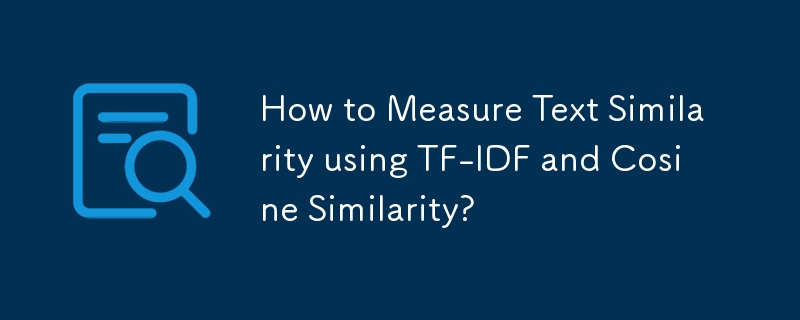 Backend Development
Backend Development
 Python Tutorial
Python Tutorial
 How to Measure Text Similarity using TF-IDF and Cosine Similarity?
How to Measure Text Similarity using TF-IDF and Cosine Similarity?
How to Measure Text Similarity using TF-IDF and Cosine Similarity?

Measuring Textual Similarity with TF-IDF and Cosine Similarity
Determining the similarity between two text documents is a crucial task in text mining and information retrieval. One popular approach involves utilizing TF-IDF (Term Frequency-Inverse Document Frequency) and cosine similarity.
TF-IDF assigns a weight to each word in a document based on its frequency in that document and its rarity across the document corpus. Documents with similar word patterns will share higher TF-IDF vectors.
Cosine similarity measures the angle between two vectors, providing a value between 0 (no similarity) and 1 (perfect similarity). In our case, the TF-IDF vectors of the two documents form these vectors, and the cosine similarity quantifies their angle.
Python Implementation
In Python, using the scikit-learn and Gensim packages, computing pairwise similarities is straightforward:
<code class="python">from sklearn.feature_extraction.text import TfidfVectorizer documents = [open(f).read() for f in text_files] tfidf = TfidfVectorizer().fit_transform(documents) pairwise_similarity = tfidf * tfidf.T</code>
Alternatively, if the documents are already strings, use:
<code class="python">corpus = ["I'd like an apple", "An apple a day keeps the doctor away", "..."] vect = TfidfVectorizer(min_df=1, stop_words="english") tfidf = vect.fit_transform(corpus) pairwise_similarity = tfidf * tfidf.T</code>
Interpreting Results
pairwise_similarity is a sparse matrix representing the similarity between each document pair. To find the document most similar to a specific document, mask out the document's similarity to itself (set it to NaN) and find the maximum value in its row using np.nanargmax():
<code class="python">import numpy as np arr = pairwise_similarity.toarray() np.fill_diagonal(arr, np.nan) input_doc = "The scikit-learn docs are Orange and Blue" input_idx = corpus.index(input_doc) result_idx = np.nanargmax(arr[input_idx]) similar_doc = corpus[result_idx]</code>
Other Considerations
For large corpora and vocabularies, using a sparse matrix is more efficient than converting to NumPy arrays.
By adjusting the parameters in TfidfVectorizer, such as min_df for minimum document frequency, the TF-IDF computation can be customized to suit specific requirements.
Additional Resources
- [Introduction to Information Retrieval](http://infolab.stanford.edu/~backrub/classes/2002/cs276/handouts/04-tfidf.pdf)
- [Computing Pairwise Similarities with Gensim](https://stackoverflow.com/questions/23752770/computing-pairwise-similarities-with-gensim)
The above is the detailed content of How to Measure Text Similarity using TF-IDF and Cosine Similarity?. For more information, please follow other related articles on the PHP Chinese website!

Hot AI Tools

Undresser.AI Undress
AI-powered app for creating realistic nude photos

AI Clothes Remover
Online AI tool for removing clothes from photos.

Undress AI Tool
Undress images for free

Clothoff.io
AI clothes remover

AI Hentai Generator
Generate AI Hentai for free.

Hot Article

Hot Tools

Notepad++7.3.1
Easy-to-use and free code editor

SublimeText3 Chinese version
Chinese version, very easy to use

Zend Studio 13.0.1
Powerful PHP integrated development environment

Dreamweaver CS6
Visual web development tools

SublimeText3 Mac version
God-level code editing software (SublimeText3)

Hot Topics
 1382
1382
 52
52
 How to solve the permissions problem encountered when viewing Python version in Linux terminal?
Apr 01, 2025 pm 05:09 PM
How to solve the permissions problem encountered when viewing Python version in Linux terminal?
Apr 01, 2025 pm 05:09 PM
Solution to permission issues when viewing Python version in Linux terminal When you try to view Python version in Linux terminal, enter python...
 How to efficiently copy the entire column of one DataFrame into another DataFrame with different structures in Python?
Apr 01, 2025 pm 11:15 PM
How to efficiently copy the entire column of one DataFrame into another DataFrame with different structures in Python?
Apr 01, 2025 pm 11:15 PM
When using Python's pandas library, how to copy whole columns between two DataFrames with different structures is a common problem. Suppose we have two Dats...
 How to teach computer novice programming basics in project and problem-driven methods within 10 hours?
Apr 02, 2025 am 07:18 AM
How to teach computer novice programming basics in project and problem-driven methods within 10 hours?
Apr 02, 2025 am 07:18 AM
How to teach computer novice programming basics within 10 hours? If you only have 10 hours to teach computer novice some programming knowledge, what would you choose to teach...
 How to avoid being detected by the browser when using Fiddler Everywhere for man-in-the-middle reading?
Apr 02, 2025 am 07:15 AM
How to avoid being detected by the browser when using Fiddler Everywhere for man-in-the-middle reading?
Apr 02, 2025 am 07:15 AM
How to avoid being detected when using FiddlerEverywhere for man-in-the-middle readings When you use FiddlerEverywhere...
 What are regular expressions?
Mar 20, 2025 pm 06:25 PM
What are regular expressions?
Mar 20, 2025 pm 06:25 PM
Regular expressions are powerful tools for pattern matching and text manipulation in programming, enhancing efficiency in text processing across various applications.
 How does Uvicorn continuously listen for HTTP requests without serving_forever()?
Apr 01, 2025 pm 10:51 PM
How does Uvicorn continuously listen for HTTP requests without serving_forever()?
Apr 01, 2025 pm 10:51 PM
How does Uvicorn continuously listen for HTTP requests? Uvicorn is a lightweight web server based on ASGI. One of its core functions is to listen for HTTP requests and proceed...
 What are some popular Python libraries and their uses?
Mar 21, 2025 pm 06:46 PM
What are some popular Python libraries and their uses?
Mar 21, 2025 pm 06:46 PM
The article discusses popular Python libraries like NumPy, Pandas, Matplotlib, Scikit-learn, TensorFlow, Django, Flask, and Requests, detailing their uses in scientific computing, data analysis, visualization, machine learning, web development, and H
 How to dynamically create an object through a string and call its methods in Python?
Apr 01, 2025 pm 11:18 PM
How to dynamically create an object through a string and call its methods in Python?
Apr 01, 2025 pm 11:18 PM
In Python, how to dynamically create an object through a string and call its methods? This is a common programming requirement, especially if it needs to be configured or run...



